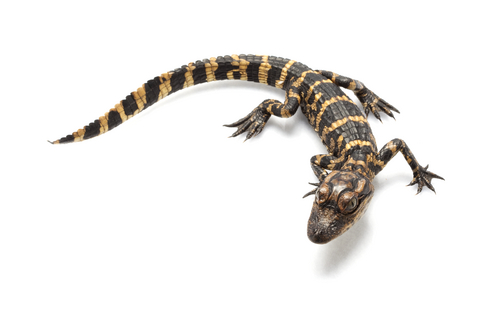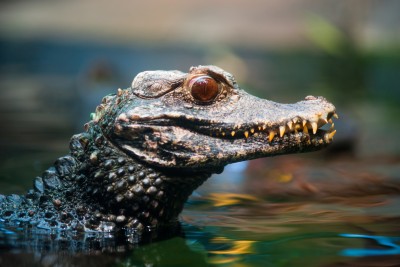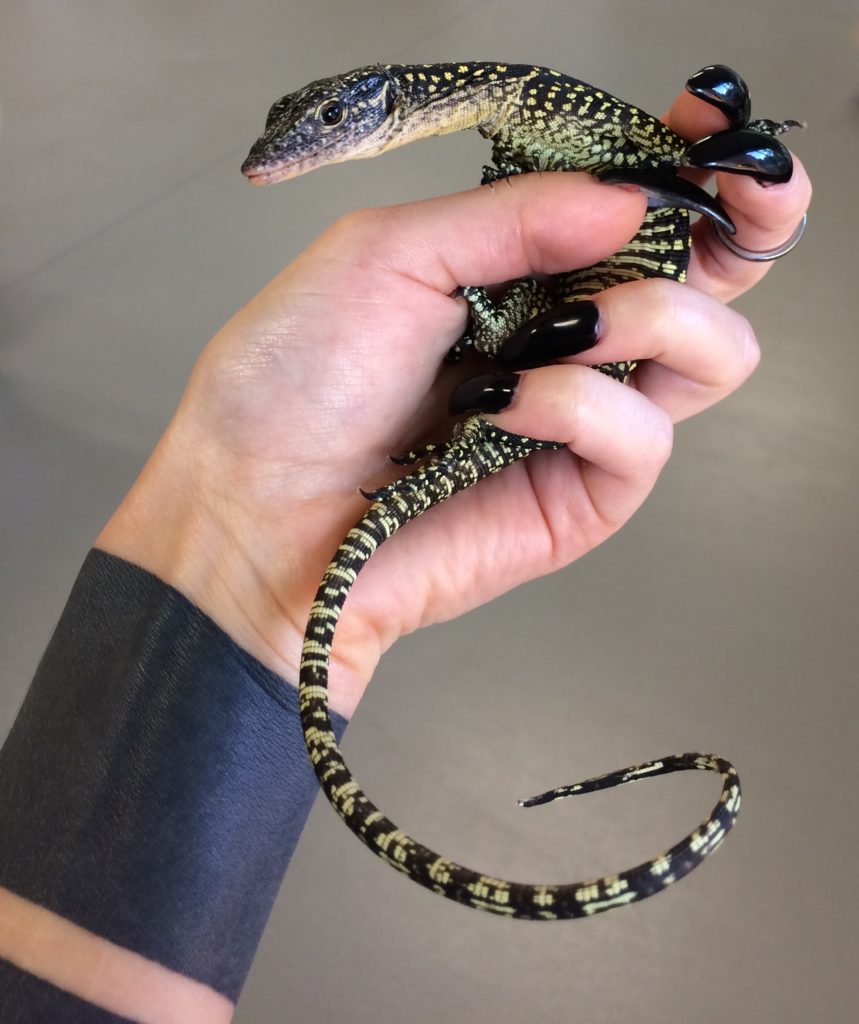Most pet reptiles sold by Backwater Reptiles can live comfortably within a tank or enclosure that maxes out around twenty gallons. However, there are some really amazing reptiles that people keep as pets that grow rather large.
While we definitely feel that these large pet reptiles make rewarding pets, it’s very true that they are not necessarily the best animals for beginners to the reptile hobby. For obvious reasons, they are also not good pets for people who have limited space, live in compact city environments, or don’t have the physical capabilities to transport such large animals when they need to leave the house (i.e. take a trip to the vet).
In this article, we will discuss our favorite large pet reptiles. We’ll go into detail about how to care for them, the pros and cons of keeping such large animals, and what is required to keep these amazing reptiles happy and healthy in captivity.
Crocodilians
We want to preface this section about pet crocodilians by making it very clear that we are NOT endorsing alligators, caimans, and other crocodilians as pets for just anyone. These animals can not only be dangerous, they have very specific care requirements in captivity that make them suitable for very special owners who can meet and understand their needs.
So please, if you are interested in owning a pet crocodilian, do your research and be prepared to handle the animal when it attains its full size.
When considering a pet crocodilian, it’s also necessary to be sure that it is actually legal to own this type of animal within your state, city, and county. Check with your local fish and wildlife department and obtain any necessary permits before adopting.
Creating a Crocodilian Enclosure
Of all the large pet reptiles discussed in this article, crocodilians are certainly the most difficult to maintain. They require a large habitat with both land and water elements as well as a specific protein-based diet and warm temperatures. In the long run, they are costly and their enclosures require quite a bit more effort to maintain and keep clean.
Even caimans, which are considered small by crocodilian standards, grow to be around five feet long. They will need an enclosure that is at least several times their body length with both aquatic and land elements. Crocodilians do spend most of their time in the water, but they do need a dry area to emerge to bask.
Despite rumors indicating otherwise, crocodilians do not stop growing to fit the size of their enclosure. So if you’re not prepared, your crocodilian can and will outgrow its home. If you don’t enlarge your pet’s space as it grows, its health and life span can be compromised.

So, how big should a crocodilian’s home be then? We recommend that the width and length of the cage, tank, or terrarium be at least three to four times the animal’s length, but the larger, the better. Your crocodilian should be able to swim around and walk around comfortably in both portions of the enclosure.
Hatchling and juvenile crocodilians tend to start out small enough to fit comfortably in glass tanks that are readily available at commercial pet stores. But be advised that as your pet outgrows the tank, odds are you will need to have some sort of custom enclosure built to keep your pet at its peak health. You’ll be hard-pressed to find the proper housing for a medium to large-sized croc at any brick and mortar store.
What to Feed Your Crocodilian
In the wild, caimans and alligators are very opportunistic predators who will eat pretty much anything they can get their jaws on. Obviously, the type of prey varies based on the size of the animal. Juveniles tend to consume foods such as insects, fish, and small amphibian and reptiles. Adults eat everything from birds to mammals. They’ll even eat crayfish and mollusks when obtainable.
The most important thing to keep in mind when feeding your pet crocodilian is that they will eat pretty much whatever you feed them, so you’ll need to balance their diet and make sure that your pet is getting all the proper nutrients in the correct doses.
In the wild, crocodilians eat entire animals and are able to therefore ingest all the minerals, vitamins, proteins, and other nutrients that are essential to their health. The best diet for a captive crocodilian is one that replicates what they eat in the wild – entire prey animals. So if your pet is large enough, whole chickens, rodents, and other feeder animals varied at meal times is a great place to start. Juveniles do well on a varied diet of fish and chopped up meat.
Handling Your Crocodilian
Caimans and other crocodilians are generally “look don’t touch” pets. However, there are some owners who actively interact with their croc. It’s generally accepted that the amount of handling will vary from owner to owner and animal to animal depending on temperament.
If you do plan to interact with your crocodilian on a regular basis, we highly recommend starting from a young age to get the animal accustomed to you. This will also make it easier when it comes time to clean your pet’s home.

Please be aware that although you can handle your crocodilian, it is always a risky move. There is ample opportunity to be bitten. We recommend having plenty of experience with these types of animals before owning one as a pet and taking preventative safety measures (i.e. wearing gloves and occasionally taping the animal’s mouth shut if need be) in order to safely move your pet from place to place.
Monitor Lizards
Although they do grow quite large, there are many species of monitor lizards that can be trained to be friendly family pets. Some Savannahs and Black Throats can be trained to go for walks on leashes, watch television with their owner, and even go on road trips. They can prove to be quite interactive companions with proper husbandry and attention.
Creating a Monitor Enclosure
The best thing to keep in mind when it comes to your pet monitor’s home is that size is extremely important. Bigger is definitely better, even for the juveniles and babies. It’s always a good idea to go with the biggest cage possible.
When your monitor is young, you can likely make due with a large, commercially-produced tank or enclosure purchased from a pet store. However, once your monitor reaches six or more feet long, it’s likely that you’ll have to order a specially built enclosure or, if you’re handy, build a cage on your own.
A large monitor should have an enclosure that is at least eight feet long, three feet wide, and six feet high. Many people construct cages using two-by-fours, wire screen, and plywood to meet these dimensions. But, we’ve even heard of specialty homes for pet monitors where entire walk in closets have been specially modified with screen doors and proper ventilation in order to give the monitor plenty of space and comfort.
No matter what size your monitor is when you purchase it, please do your research and be prepared to handle it when it grows to its full potential.
What to Feed Your Monitor
In the wild, monitors are opportunistic hunters. They will eat virtually anything appetizing that fits in their mouth. The primary diet of each monitor species varies from habitat to habitat, but the most commonly consumed monitor meals are: eggs, birds, small mammals and rodents, crustaceans, fish, and even other smaller reptiles.
Monitor lizards of all species, sizes, and genders require a balanced diet in order to stay healthy. Nearly all will have ravenous appetites and consume virtually any food you give them, so it is up to you as an owner to be sure you are feeding nutrient rich meals that cover all the bases when it comes to vitamins, minerals, and protein.
So what are acceptable foods for pet monitors?
Juvenile and hatchling monitors are pretty easy to feed. They will readily eat insects such as crickets, roaches, reptiworms, and waxworms. Gut loaded insects are the best option as they are fed nutritionally dense food in order to be as nourishing as possible for your pet.
Pet monitors of all sizes can also be fed commercially produced pellets from the pet store. While these pre-packaged food items are certainly nutritionally dense, we don’t recommend making them your monitor’s only food source. It is always a good idea to vary the food your lizard eats.
Mice and rats are also good in moderation. We highly recommend using frozen rodents that have been thawed as it is safer and more humane for all parties involved in the feeding process. Believe it or not, live rodents can actually put up quite a fight and harm your monitor.
Many other common super market food items can also be fed to your monitor. Raw chicken, fish, shrimp, turkey, and eggs are all acceptable options. The only thing to keep in mind when feeding any type of meat is that you will need to cut up or chop the meat into acceptably sized pieces. Most monitors gulp their food without chewing, so anything that is too large can cause impaction in the gut and an unwanted trip to the vet.
As with most pet of all kinds, a water dish is a requirement for all monitor species. Not only will your monitor drink water, but a water dish allows for soaking and aids with making sure the environment is humid enough.
Handling Your Monitor
As we’ve already mentioned, pet monitors can be far more interactive than a pet crocodilian. If you handle your monitor regularly from a young age, you can train it to become very docile and accustomed to human interaction.
Monitors are very intelligent as far as reptiles are concerned and they can sense discomfort, fear, and anxiety in their owners, so be sure that you approach your monitor with a calm demeanor and patience.

Baby monitor lizards can be skittish and fearful, so it is best to handle them on a daily basis in a routine manner so that they learn to associate human interaction with a reward. Offering a treat item before, during, or directly after being picked up, handled, or otherwise played with is a great way to reinforce positivity and teach them that being removed from their enclosure is nothing to be afraid of.
Savannah monitors are particularly known for being “dog-like” in their interactions with their owners. As they mature and grow larger, many enjoy being walked outdoors on a leash and soaking up sunshine. They enjoy bath time, anticipate meal time, and enjoy sitting on their owner’s lap during down time. Many Savannahs will even fall asleep with their owner on the couch – just Google it!
Conclusion
Both monitors and crocodilians are very different as pets. Crocodilians are best as “look don’t touch” animals whereas many species of monitors actually thrive when allowed to bond with their owner.
The one thing that both large reptile species have in common when it comes to a life in captivity is that they both require large, often times specially built enclosures. They are active animals and will need plenty of space to accommodate their size and habits.
Again, although this article is dedicated to keeping these amazing reptiles in captivity, we can’t stress enough that if you are considering getting either a crocodilian or a monitor lizard as a pet that you do your research and be one hundred percent prepared to care for the animal for the duration of its life. This includes being fully prepared for their voracious appetites and extremely fast growth rates.
